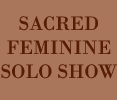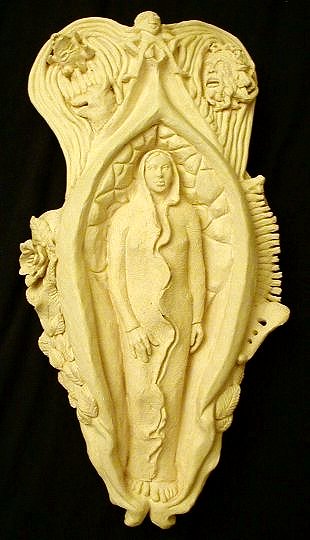
|
|
|
|
About the Piece This yoni-as-woman provides the yoni with a face, an identity, a soul and personalizes it. The symbols in the upper part of the sculpture represent parts of the woman's psyche. These thoughts recede and advance from bands that represent how thoughts fade in and out of our consciousness. The dog represents dependence, the vejigante mask relates to our dark side. The man's face, from Lacoon, depicts pain and suffering. The sheila-na-gig, at the top of the sculpture, is the trickster that reveals to us the mysteries of women. On one side of the woman, roses represent growth and fruitfulness; on the other side a spine signifies backbone and strength. By placing the woman's head at the locus of the clitoris, a clitoris-as-mind connection is formed. For me, the clitoris represents a woman's ability to give pleasure to herself. By symbolically superimposing mind and clitoris, pleasure is paired with intellect, responsibility, and choice. The folds of her robe are the inner lips of the yoni. The mandorla/almond shape around her are the modified outer lips of the yoni. This piece draws inspiration from Virgin of Guadalupe by Yolanda M. Lopes. In her portrait, Lopes paints herself as the Virgin surrounded by the traditional framework of the mandala. This aura around Lopes' body, and the pink folds of her skirt, look like a yoni. Yoni with Woman is also a response to Judy Chicago and Edward Lucie-Smiths' ideas on Gustave Courbet's painting The Origin of the World from Women and Art: Contested Territory (1999, p.144-145). Smith writes "Not all of Wesselman's paintings are as sexually emphatic as the example illustrated (Helen, 1966), but kinship with Courbet's work is obvious. Female potentiality is reduced to one thing-the ability to give sexual pleasure to men." What I appreciate about The Origin of the World is its frankness. It does not appear as pornography to me, which is unauthentic and degrading. The canvas looks enclosed; if the canvas were widened and the view pulled back we would see a specific woman, the bedroom of Courbet and his lover/wife. The woman's robes have a soft rhythm to them. I can find no comparison between Courbet and Tom Wesselman's Helen. I abhor Helen by Wesselman. (Unless Wesselman is a feminist who is holding a mirror to us to show us how vile we can be to women). Once again, artist motivation is very weighty. Lucy Lippard writes: "It is a subtle abyss that separates men's use of women for sexual titillation from women's use of women to expose that insult." (Chicago & Lucie-Smith 1999, p. 144). The question of subject versus object leads me to compare the photographs found in Femalia (1993) by Blank with Origin of the World. I realize the woman in Courbet's Origin lacks arms (action), legs (mobility), and a head (individuality and brains). I wonder what Lucie-Smith would think of Joani Blank's Femalia (1993). Blank's vulvas are similar to Courbet's Origin in that neither have legs, heads, arms, etc. The vulvas in Femalia are not "general" non-specific cunts; each cunt in Femalia has a personality, a distinct face. Is Courbet's Origin too generalized? Would it be less offensive to Smith if Courbet had included her face, arms, and legs, the model looking at something or engaged in an activity? Perhaps the difference between Courbet and Joani Blank is their intent. One would have needed to talk with Corbet to learn his motives. However, the title The Origin of the World clearly shows Courbets relationship to his subject. Courbet paints this woman as a Goddess or archetype of creation, celebrating her ability to give life. She is the origin of the world; a title of great honor. Yet, some have suggested Courbet's picture objectifies the woman-- i.e she looks like she is in his bed, her nightgown pushed up as if he has just had sex with her and he is now painting her while she sleeps. I find Venus of Willendorf more unsettling-- the feet are very small, the arms are short, and there is no face. In this way, Venus of Willendorf is a realistic portrayal of what it feels like to be pregnant. When pregnant, women's mobility, action and self are subsumed by the pregnancy. Still, the small feet, short arms, and facelessness seem to wipe out all other aspects of her personhood, and only highlight those which relate to her reproductive functions. If Origin of the World was made/painted by a woman would we be upset? Why is the Washington Monument not seen as symbolic and reducing a man to anonymity and only his sexual phallus? My only answer to this question is that men are in a more powerful position in the world and do not have to worry about being subordinated object of the female gaze. Also, the phallus has historically been imbued with attributes of strength and stature, whereas the yoni has been consistently depicted as passive and receptive.
|



